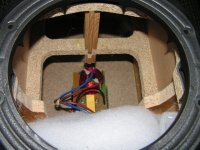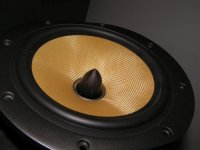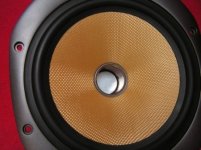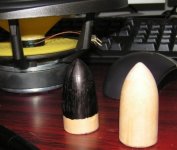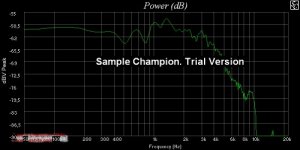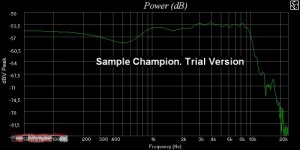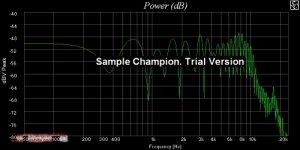Hi
I am now the happy owner of a pair of modified 602 S3 and thought it might be useful to share my experience. There are two things I have done:
1. Stabilized the cabinets. As it can be seen in the picture, I added two "ribs" on the lateral walls just aside the woofer and a piece of hard wood that links the back, front and the original middle reinforcement of the cabinet. The front is build like a low resonance sandwich of wood, plastic (filled with mica, according to B&W) and the aluminium chassis of the woofer, but I backed the plasic with some self-adhesive bitum tape to further reduce resonance.
I am now the happy owner of a pair of modified 602 S3 and thought it might be useful to share my experience. There are two things I have done:
1. Stabilized the cabinets. As it can be seen in the picture, I added two "ribs" on the lateral walls just aside the woofer and a piece of hard wood that links the back, front and the original middle reinforcement of the cabinet. The front is build like a low resonance sandwich of wood, plastic (filled with mica, according to B&W) and the aluminium chassis of the woofer, but I backed the plasic with some self-adhesive bitum tape to further reduce resonance.
Attachments
2) Actually THE modification: I removed the plastic dustcap of the woofer and installed phase plugs !
The plugs are made of wood, I tried to keep the shape of the dustcap (it resembles the phase plug of the B&W 700 and 800 series). THere are a few aspects that must be considered when performing the operation:
- I wouldnt try to remove the cap by pulling it in any way, because it it firmly glued to the Kevlar cone. Instead, I have cut it with a cutter (and attention) just at its base, leaving a plastic ring glued on the cone.
- the plugs can be gluet to the pole piece without problems.
- the voice coil has 4 holes in it, just behid the spider, that serve to eliminate compression behind the dust cap. With the dustcap removed, these holes are now openings between the interior and the exterior of the cabinets, which is not goot. Make sure you cover them (I used adhesive paper tape, for protection by paining), they make a HUGE difference.
That's it.
The plugs are made of wood, I tried to keep the shape of the dustcap (it resembles the phase plug of the B&W 700 and 800 series). THere are a few aspects that must be considered when performing the operation:
- I wouldnt try to remove the cap by pulling it in any way, because it it firmly glued to the Kevlar cone. Instead, I have cut it with a cutter (and attention) just at its base, leaving a plastic ring glued on the cone.
- the plugs can be gluet to the pole piece without problems.
- the voice coil has 4 holes in it, just behid the spider, that serve to eliminate compression behind the dust cap. With the dustcap removed, these holes are now openings between the interior and the exterior of the cabinets, which is not goot. Make sure you cover them (I used adhesive paper tape, for protection by paining), they make a HUGE difference.
That's it.
Attachments
I will come back soon with a few words on the sound. To me , it was all worth the effort, especially the phase plugging is spectacular. A link on phase plugs (and beyond):
http://www.mother-of-tone.com/speaker.htm
http://www.mother-of-tone.com/speaker.htm
Now, as I promised, a few words on technical background and sound experience.
First, why a phase plug ? For a mid-woofer it is only efective if it radiates relatively high frequencies. This obviously apply for the 602s, since the declared crossover point is 4kHz and the low pass filter is first order, which means that the woofer radiates well above 4kHz !
Now, the results:
I started with a mistake: I left the speaker in the previous arrangement, that is, strongly toed in. Very wrong. With a phase plug, the directivity of the speaker is changed to a great extent. Although a difference could be heard, I found the sound dull. Then , after a few measurements with a SPL-meter (I'll come to that later) it occured to me: I should experiment with different orientation. The difference was huge ! As I progressively oriented the speakers only a bit toed in, not only the soudstage was at a level that I never experienced before, but the tonal balance was back ! Phase plug speakers are MUCH more sensitive to positioning than dust caps, it seems.
I must say again, the difference is spectacular. First, the mids are much more coherent, natural and better defined. I realized that - as pointed out by others too - the harsh sound of the 602 is NOT due to the metallic tweeter, but to the mid-woofer. That I expected.
What I neither expected nor can explain is a spectacular gain in bass bodyness and definition - maybe this is because low frequencies are not masked by "mid-noise" anymoore.
First, why a phase plug ? For a mid-woofer it is only efective if it radiates relatively high frequencies. This obviously apply for the 602s, since the declared crossover point is 4kHz and the low pass filter is first order, which means that the woofer radiates well above 4kHz !
Now, the results:
I started with a mistake: I left the speaker in the previous arrangement, that is, strongly toed in. Very wrong. With a phase plug, the directivity of the speaker is changed to a great extent. Although a difference could be heard, I found the sound dull. Then , after a few measurements with a SPL-meter (I'll come to that later) it occured to me: I should experiment with different orientation. The difference was huge ! As I progressively oriented the speakers only a bit toed in, not only the soudstage was at a level that I never experienced before, but the tonal balance was back ! Phase plug speakers are MUCH more sensitive to positioning than dust caps, it seems.
I must say again, the difference is spectacular. First, the mids are much more coherent, natural and better defined. I realized that - as pointed out by others too - the harsh sound of the 602 is NOT due to the metallic tweeter, but to the mid-woofer. That I expected.
What I neither expected nor can explain is a spectacular gain in bass bodyness and definition - maybe this is because low frequencies are not masked by "mid-noise" anymoore.
Its very probable you created a dip in the power response. Hence the new 3D and bass. Fine since you like it.
If the dustcap was particularly irritating in its aid to maximize mid output, maybe your 'wrong' is better than B&W's 'wrong'.
If the dustcap was particularly irritating in its aid to maximize mid output, maybe your 'wrong' is better than B&W's 'wrong'.
Member
Joined 2002
salas said:Its very probable you created a dip in the power response. Hence the new 3D and bass. Fine since you like it.
If the dustcap was particularly irritating in its aid to maximize mid output, maybe your 'wrong' is better than B&W's 'wrong'.
I honestly don't think so, although I also cannot be 100% sure by now.
I have done some (pseudo-)measurements that showed that there should not be any massive response dip on the woofer. Because I don't have a proper measurement system yet, I had to use a hand held analogue SPL meter - which seemed quite sensitive though !
Of course, I also don't have an anechoic room, but it is well damped and I placed the speakers in the middle and such as to minimize reverberation.
I have measured the midwoofer section(with first order LPF) from approx. 50 cm in the range 1-5kHz. The response showed close to linear up to 3500 Hz(within 1-1.5dB), then it fell slowly - something one can expect from a first order LPF (B&W declares a 4kHz crossover point, at which the woofer was still at -1 dB or so). The off axis response was fairly constant (within 1dB) up to 30 degrees.
I have also measured the entire box. While there are some (small) amplitude variations arround the crossover point, they might either have been there before too, or due to the room influence.
Please note that I don't claim accurate mesurements - they are far from it. But they did show that there are no huge problems (like 5dB dips) and actually do suggest that the woofer still does its job well - this is also confirmed by the sound: the mids are not recessed, but lively. But ff there is a slight dip, one could correct it by reducing the value of the inductor in series with the woofer. I also remarked that it might be just silly to try have an ultra linear anechoic response , since a quick measurement from my listening place with the speakers on their stands, showed a pretty chaotic response - which however let itself improve by orienting the speakers in a different way.
A last theoretical note: a phase plug should also extend the frequency range of a speaker, by eliminating cancelations at the higher frequency radiated by the central part of the speaker. So, what you give up by removin a cheap plastic resonant dust cap, you might gain back with the phase plug. This should be particularly true for the B&W kevlar speakers, because they are purposely designed with a non-stiff membran such that, as the frequency increases, only the central part of it radiates (something like a controlled cone breakup).
I hope to be able to come up with more accurate measurements, I would appreciate any hints and advices in this respect.
jleaman said:WOW! Good work.. I bet you were scared tho when you were cutting tho 🙂..
Jase
I was only scared of what I might find inside
 😀
😀Member
Joined 2002
Some times Manufactured speakers can be scary they look really pretty on the outside and ( sometimes on paper ) but the inside just makes you want to take it back and DEMAND your money. I bought a pair of book shelf speakers from A&B sound for 50$ 2 years ago.. I was suprized to see the boxes made of real mdf and not partical board 😀 So far i still use them and like them.
The fact that you had to toe em out is a sign of reduced power response. But no big deal since you could regain balance.
I've also measured the whole loudspeaker. There seems to be no indication of a frequency response dip. A slightly increased, B&W typical high frequency response can be noticed (it also seems that my microphone does not respnd above 10-12 kHz anymoore).
So it looks safe on the technical side..(to me). As to the sound, I have already covered this sobject before.
So it looks safe on the technical side..(to me). As to the sound, I have already covered this sobject before.
Attachments
In both cases the distance was ~1m.
The woofer was measured roughly on its axis, while the whole loudspeaker was measured roughly on the tweeter axis, which is closer to the real setup (ear height is approx. on the tweeter axis)
However, I have also done measurements from my listening position (~3m from loudspeaker and ~10 degrees off axis). In this case, the direct and reflected components of the signal are much more closer to each other, so you can select both on the time axis and have a summed response of loudspeaker and room reflection.
Of course, the summed response was quite chaotic with dips all over, but the direct component was almost perfectly linear !!! I have previously seen measurements of 602 S2s which were also better slightly off-axis.
The woofer was measured roughly on its axis, while the whole loudspeaker was measured roughly on the tweeter axis, which is closer to the real setup (ear height is approx. on the tweeter axis)
However, I have also done measurements from my listening position (~3m from loudspeaker and ~10 degrees off axis). In this case, the direct and reflected components of the signal are much more closer to each other, so you can select both on the time axis and have a summed response of loudspeaker and room reflection.
Of course, the summed response was quite chaotic with dips all over, but the direct component was almost perfectly linear !!! I have previously seen measurements of 602 S2s which were also better slightly off-axis.
Attachments
From what I see, the mic is totally uncalibrated. I cant make out useful conclusions. Live aside that to take power response you need to average a grid of readings (maybe 20) over a 1,5m(h) x 2,5m (w) window around your ear at listening position for both speakers (one and then the other and sum the averages) using pink noise. Leave it at that. If it sounds ok, its ok.
What do you mean by "uncalibrated" and how did you draw this conclusion?
I just measured the relative response of the speaker, I do not care much about absolute values. If you mean the mic might be non-linear, then you may be right, but the deviation should be small. I intend tu ose a proper mic in the future though.
I just measured the relative response of the speaker, I do not care much about absolute values. If you mean the mic might be non-linear, then you may be right, but the deviation should be small. I intend tu ose a proper mic in the future though.
- Status
- Not open for further replies.
- Home
- Loudspeakers
- Multi-Way
- B&W 602 S3 mods
